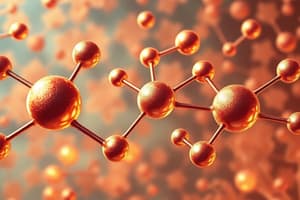Podcast
Questions and Answers
Is Cl2 polar or nonpolar?
Is Cl2 polar or nonpolar?
nonpolar
What is the bond angle in a trigonal planar molecule?
What is the bond angle in a trigonal planar molecule?
120 degrees
What is the bond angle in a tetrahedral molecule?
What is the bond angle in a tetrahedral molecule?
109.5 degrees
What is the bond angle in a bent molecule?
What is the bond angle in a bent molecule?
What is the bond angle in a linear molecule?
What is the bond angle in a linear molecule?
Is trigonal planar polar or nonpolar?
Is trigonal planar polar or nonpolar?
Is tetrahedral polar or nonpolar?
Is tetrahedral polar or nonpolar?
Bent is always polar.
Bent is always polar.
What is the structure and angle in a trigonal pyramidal molecule?
What is the structure and angle in a trigonal pyramidal molecule?
Is trigonal pyramidal polar or nonpolar?
Is trigonal pyramidal polar or nonpolar?
Do we care about polarity?
Do we care about polarity?
What can have polarity?
What can have polarity?
What is a polar covalent bond?
What is a polar covalent bond?
What is a non-polar bond?
What is a non-polar bond?
What is electronegativity?
What is electronegativity?
Does electronegativity increase or decrease across a period?
Does electronegativity increase or decrease across a period?
Does electronegativity increase or decrease down a group?
Does electronegativity increase or decrease down a group?
What is shielding in chemistry?
What is shielding in chemistry?
What does the difference in electronegativity tell us?
What does the difference in electronegativity tell us?
What is a polar bond difference in electronegativity?
What is a polar bond difference in electronegativity?
What is a non-polar bond difference in electronegativity?
What is a non-polar bond difference in electronegativity?
What is an ionic bond?
What is an ionic bond?
What is the electronegativity difference for an ionic bond?
What is the electronegativity difference for an ionic bond?
What is a molecule?
What is a molecule?
What is an example of a molecule?
What is an example of a molecule?
What is a covalent bond?
What is a covalent bond?
What is a compound?
What is a compound?
What are examples of compounds?
What are examples of compounds?
What is the octet rule?
What is the octet rule?
What is BrINClHOF?
What is BrINClHOF?
What is a Lewis Dot Structure?
What is a Lewis Dot Structure?
Flashcards are hidden until you start studying
Study Notes
Molecular Polarity
- Cl2 is a non-polar molecule due to equal electron distribution between two chlorine atoms.
- Polarity in trigonal planar molecules depends on the atoms involved: non-polar if the same atoms are present, polar if different.
Molecular Geometry and Angles
- Trigonal planar shape has bond angles of 120 degrees.
- Tetrahedral shape features bond angles of 109.5 degrees.
- Bent shape exhibits bond angles of 104.5 degrees.
- Linear shape has bond angles of 180 degrees.
- Trigonal pyramidal geometry consists of 3 bonds and 1 lone pair, with bond angles of 107 degrees.
Polarity Characteristics
- Bent molecules are always polar.
- Tetrahedral shapes remain non-polar when all peripheral atoms are identical.
- Trigonal pyramidal structures are inherently polar due to uneven charge distribution.
Significance of Polarity
- Polarity is a helpful concept for understanding molecular behavior, even if not of direct concern.
- Only covalent bonds can exhibit polarity.
Bonding Concepts
- A polar covalent bond arises when electrons are shared unequally between atoms.
- A non-polar bond occurs when electrons are shared equally.
- Electronegativity measures an atom's ability to attract electrons in a chemical compound.
Electronegativity Trends
- Electronegativity increases across a period on the periodic table.
- Electronegativity decreases down a group.
Shielding Effect
- Shielding occurs when core electrons block the attractive force of the nucleus on valence electrons.
Electronegativity Differences and Bonding Types
- A difference in electronegativity indicates polarity in bonds:
- Polar bonds have a difference of 0.5 to 1.9.
- Non-polar bonds feature a difference of 0.0 to 0.4.
- Ionic bonds typically arise with a difference greater than 1.9, leading to the formation of charged ions, generally between metals and non-metals.
Molecular and Compound Definitions
- A molecule is defined as two or more atoms held together by covalent bonds (example: H2O).
- A compound consists of two or more elements chemically combined (examples: H2O, NaCl).
Octet Rule
- The octet rule states that atoms tend to lose, gain, or share electrons to achieve a full set of eight valence electrons, promoting stability.
Diatomic Molecules
- BrINClHOF refers to the diatomic elements: Bromine, Iodine, Nitrogen, Chlorine, Hydrogen, Oxygen, and Fluorine.
Lewis Dot Structure
- A Lewis Dot Structure is a diagram representing a molecule using dots to indicate valence electrons, providing insight into bonding and molecular configuration.
Studying That Suits You
Use AI to generate personalized quizzes and flashcards to suit your learning preferences.




